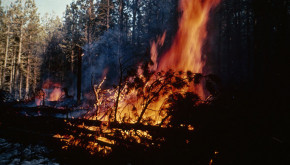
Photo by USDA Forest Service - Region 2 - Rocky Mountain Region
Ponderosa pine forests of the Southwest are home to the native bark beetle. However, human influence, denser forests, and increased temperatures and drought events have led to recent bark beetle outbreaks that threaten the health of ponderosa stands. Where dead trees stand, fire can move as much as three times more rapidly, creating dangerous conditions for firefighters and residents. Restoration treatments can be used to help restore the balance needed in ponderosa pine ecosystems.
Prescribed fires can be used to help treat unhealthy ponderosa pine stands. In a controlled environment under safe conditions, prescribed fire can mimic the natural disturbance in the stand, resulting in less severe fire effects than a wildfire in a beetle-killed stand. Prescribed fires also can remove stressed trees, which are more susceptible to bark beetle outbreaks.
Thinning treatments also help counter the threat of a bark beetle outbreak. Bark beetle populations thrive in dense, overcrowded forests, but have greater difficulty spreading from tree to tree in thinned stands. Tree thinning changes the air temperature and light exposure, making trees in thinned stands less desirable places for bark beetles to set up shop. Furthermore, thinning a forest reduces competition between trees and leaves the strongest, most vigorous ones to grow.
Bark beetles are part of the natural ponderosa pine ecosystem. By using treatments such as prescribed fire and thinning, humans can help restore the natural balance of these beetles in the forest while making it a safer, healthier ecosystem.
For more information about bark beetles and restoration, see:
http://www.swfireconsortium.org/wp-content/uploads/2017/10/Bark-Beetle-Factsheet_Update.pdf

